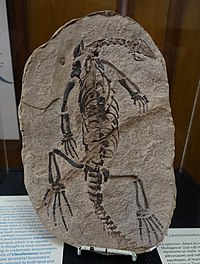Claudiosaurus
| Claudiosaurus Temporal range: Lopingian
~ | |
|---|---|

| |
| Specimen of Claudiosaurus germaini, on display at the Redpath Museum, Montreal | |
| Scientific classification | |
| Domain: | Eukaryota |
| Kingdom: | Animalia |
| Phylum: | Chordata |
| Class: | Reptilia |
| Family: | †Claudiosauridae Carroll 1981 |
| Genus: | †Claudiosaurus Carroll 1981 |
| Type species | |
| †Claudiosaurus germaini | |
Claudiosaurus (claud is Latin for "lameness" and saurus means "lizard") is an extinct genus of diapsid reptiles from the Permian Sakamena Formation of the Morondava Basin, Madagascar. Claudiosaurus is the most basal neodiapsid. Claudiosarus are found to be a sister group of the Neodiapsida. The pattern of the vertebrate, girle, and limbs indicates that Claudiosaurus and Thedeosaurus share a common ancestor.
History and discovery
Claudiosaurus is known from the Sakamena Formation of Madagascar. Originally claudiosaurs were found from the Late Permian, but they have been recently also found in Early Triassic deposits of Madagascar.
Biology and description

Claudiosaurus was one of the first members of the Neodiapsida,[1] a group of reptiles containing diapsids more derived than the primitive Araeoscelidia. It had a relatively long body and neck, reaching on overall length of about 60 centimetres (2.0 ft). It is presumed to have been partially oceanic, living its life in a way similar to the modern marine iguana. The main reason for this theory is that the skeleton included substantial amounts cartilage, rather than bone, indicating it had trouble supporting its weight on land. In particular, the sternum was poorly developed, which would have made walking difficult out of water. Instead, it probably swam by undulating its body and tail, and holding its legs close to the body to increase streamlining.[2] A more recent study however indicates that its vertebral column tail and leg proportions are closer to those of terrestrial reptiles, though it is noted that marine iguanas similarly only differ from terrestrial counterparts very subtly.[3] The mean vertebral is approximately twice of Hovasaurus. Claudiosaurus have a more slender tail than Hovasaurus. The frontal contributes the dorsal orbital margin. This prevents the prefrontal from contacting the post frontal. The post frontal is ventrally expanded posteriorly and contributes to the orbital rim. The anterior process of the pterygoid is straight. The closest skull comparison can be with the genus Anarosaurus. Claudiosaurus differs from Acerosodontosaurus and Hovasaurus in the presence of a proportionately long neck.[citation needed]
Behavior
Locomotion
It is theorized[by whom?] that Claudiosaurus was semi-aquatic.[citation needed] The discovery of pachyostotic thickening of the limb bones and vertebrae supports this theory. The margins of contact in the carpals are poorly defined and therefore retained a lot of cartilage, providing a greater ‘ degree of flexibility’ that would be beneficial for swimming.
Feeding ecology
There is evidence of aquatic feeding habits. Supporting this is the small size of the skull, nature of the palate and marginal dentition and the long neck.[citation needed]
Classification
Claudiosaurus is recovered as a relative of turtles by Li et al. (2018), forming a clade with the basal neodiapsid Acerosodontosaurus.[4]
References
- ^ Carroll, R. L. (1981). "Plesiosaur ancestors from the upper permian of Madagascar". Philosophical Transactions of the Royal Society. B. 293 (1066): 315–383. doi:10.1098/rstb.1981.0079.
{{cite journal}}: Invalid|ref=harv(help) - ^ Palmer, D., ed. (1999). The Marshall Illustrated Encyclopedia of Dinosaurs and Prehistoric Animals. London: Marshall Editions. p. 72. ISBN 1-84028-152-9.
- ^ Pablo Nuñez Demarco et al. Was Mesosaurus a Fully Aquatic Reptile? Front. Ecol. Evol, published online July 27, 2018; doi: 10.3389/fevo.2018.00109
- ^ Chun Li; Nicholas C. Fraser; Olivier Rieppel; Xiao-Chun Wu (2018). "A Triassic stem turtle with an edentulous beak". Nature. 560 (7719): 476–479. doi:10.1038/s41586-018-0419-1.
Further reading
- McMenamin, M. Permian Aquatic Reptiles. Preprints 2019, 2019080033 (doi: 10.20944/preprints201908.0033.v1). McMenamin, M. Permian Aquatic Reptiles. Preprints 2019, 2019080033 (doi: 10.20944/preprints201908.0033.v1).
- Carroll, R. (1981). Plesiosaur Ancestors from the Upper Permian of Madagascar. Philosophical Transactions of the Royal Society of London. Series B, Biological Sciences, 293(1066), 315-383. Retrieved February 5, 2020, from www.jstor.org/stable/2396139
- Pablo Nuñez Demarco, Melitta Meneghel, Michel Laurin, Graciela Piñeiro. Was Mesosaurus a Fully Aquatic Reptile? Frontiers in Ecology and Evolution, 2018; 6 *
Caldwell, M. (1995). Developmental Constraints and Limb Evolution in Permian and Extant Lepidosauromorph Diapsids. Journal of Vertebrate Paleontology, 14(4), 459-471. Retrieved February 5, 2020, from www.jstor.org/stable/4523588
- Sues, H. (2019). The Rise of Reptiles: 320 Million Years of Evolution. Baltimore: Johns Hopkins University Press., doi:10.1353/book.67468.
- CUTHBERTSON, R., RUSSELL, A., & ANDERSON, J. (2013). CRANIAL MORPHOLOGY AND RELATIONSHIPS OF A NEW GRIPPIDIAN (ICHTHYOPTERYGIA) FROM THE VEGA-PHROSO SILTSTONE MEMBER (LOWER TRIASSIC) OF BRITISH COLUMBIA, CANADA. Journal of Vertebrate Paleontology, 33(4), 831-847. Retrieved March 3, 2020, from www.jstor.org/stable/42568652
- Stomach stones for feeding or buoyancy? The occurrence and function of gastroliths in marine tetrapods341Phil. Trans. R. Soc. Lond. Bhttp://doi.org/10.1098/rstb.1993.0100





